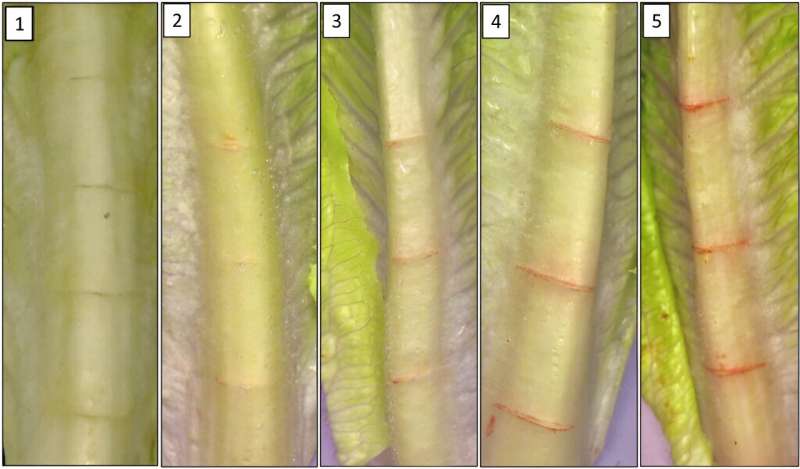
Lettuce (Lactuca sativa) is primarily produced in the United States in California, Arizona, and Florida, with a production value of $2.7 billion (USDA-NASS 2021). Florida produces an estimated 3% of the total lettuce in the United States (USDA-NASS 2019), primarily in the Everglades Agricultural Area, which is a humid subtropical region in southern Florida. Despite this relatively low proportion of the industry in the United States, lettuce grown in Florida has significant market demand because it is harvested during winter and spring months.
The expected shelf life of lettuce is 2 to 3 weeks when promptly cooled and held at 1 °C and 95% to 100% relative humidity. Shelf life is limited by several postharvest factors, including physiological disorders such as russet spotting, brown stain, and pink rib or pinking. Maintaining recommended field and postharvest conditions reduces its incidence but does not eliminate these disorders.
During the past decade, research has identified tolerance to pink rib disorder among lettuce types and cultivars grown in cooler climates. However, tolerance to pink rib among lettuce types grown in humid subtropical climates has been unknown; therefore, it has been necessary to screen lettuce germplasm stressed under these growing conditions.
In a new study published in the Journal of the American Society for Horticultural Science, diverse lettuce accessions were planted for early season, mid-season, and late-season harvests over two winter/spring seasons in Belle Glade, FL.
Harvested midribs were wounded to induce pink rib, stored under simulated commercial conditions for 6 to 9 days at 5 °C and >95% relative humidity, and rated for severity using a 5-point subjective scale. Genotype × environment interactions were evaluated to understand the environmental factors that favor the development of pink rib during storage and between planting seasons
Reducing pink rib severity of whole-head lettuce is a focus for multiple breeding programs; however, there have been no reports of long-term solutions, such as new cultivars or exogenously applied compounds that can reduce or eliminate the development of pink rib. Therefore, the identification of accessions with lower susceptibility to pink rib is essential for the long-term mitigation of this disorder. In the current study, lettuce accessions with less susceptibility to pink rib severity were identified from germplasm adapted to a humid subtropical climate.
This is the first study to identify genetic variation of pink rib severity among diverse lettuce accessions adapted to humid subtropical growing conditions. Although the cultivars Cordoba and Galactic had less pink rib severity across all the tested accessions among all types, accessions with the least pink rib severity were identified within each type.
For instance, Hialeah and Holbrook in romaine, H1098 in crisphead, B1190 in butterhead, and 45060 in Latin types showed less pink rib severity. Developing mapping and breeding populations that combine low susceptibility to pink rib of these accessions with other desirable quality and horticultural characteristics should be a priority for genetics studies and breeding purposes.
More information:
Catherine E. Belisle et al, Lettuce Germplasm in Humid Subtropical Environments Tolerant to Postharvest Development of Pink Rib Disorder, Journal of the American Society for Horticultural Science (2023). DOI: 10.21273/JASHS05295-23
Citation:
Study evaluates pink rib disorder tolerance in lettuce germplasm in humid subtropical environments (2024, January 4)
retrieved 4 January 2024
from https://phys.org/news/2024-01-pink-rib-disorder-tolerance-lettuce.html
This document is subject to copyright. Apart from any fair dealing for the purpose of private study or research, no
part may be reproduced without the written permission. The content is provided for information purposes only.

